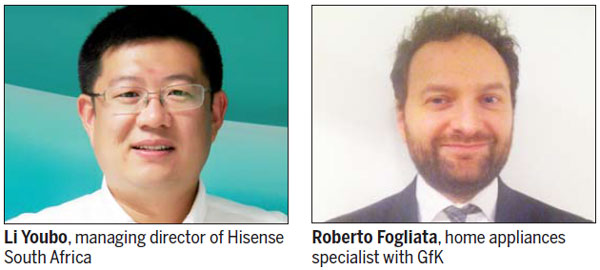
African households revel in good times with Chinese characteristics
Whether they are in the lounge, in the kitchen or elsewhere in their homes, Africans are now being given a front-row view of how their world, and the world of trade, is changing.
Their guides are the appliances they use to make their lives easier, appliances that used to carry names such as Philips, Samsung and Sanyo, but that now increasingly bear names such as Haier, Hisense or Shinco.

|
Hisense set up its Cape Town factory in 2013, and began to export TVs and refrigerators to 10 other African countries last year. Provided to China Daily |
|
Haier makes home appliances tailored to African countries. Provided to China Daily |

The prevalence of these names is the result not only of the highly competitive prices at which they are sold, but also of an unrelenting drive by Chinese companies to innovate and to localize everything they sell.
In turn, the success of the likes of Haier, Hisense and Shinco in localizing their products for Africa is spurring other Chinese home appliance and electronics companies to make similar efforts, looking to cash in on an increasingly prosperous continent with its growing middle class and cheap labor.
Broad acceptance across the continent of Chinese appliance brands is still some distance off, but once that process is well under way it will suggest a fundamental shift in sentiment about anything made in China.
What is driving Chinese appliance makers to Africa is not just its undoubted economic promise, but a problem they now face at home: market saturation, which is forcing them to broaden their horizons as they look to keep or increase market share.
More than 45 percent of the refrigerators, washing machines and TVs in the world were made in China, a report by the Development Bank of Singapore in 2013 said. Seventy-five percent of air conditioners and small appliances were made in China, the report said.
China's experience in supplying such goods means its companies have gained expertise in gauging consumer needs. But Africa, a market with widely varying markets from region to region and country to country, presents particular challenges.
Economic growth in sub-Saharan Africa is particularly strong, and the home appliance market is driven by population growth and the rise of the middle class, says Roberto Fogliata, a home appliances specialist responsible for sub-Saharan Africa for the international market research company GfK. "This is not only a fact today, but it is by its very nature a long-term given."
Standard Bank of South Africa said last year that the middle class in Africa had grown substantially over the past 14 years.
In a report titled Understanding Africa's Middle Class, it said there were 15 million middle-class households in 11 of sub-Saharan Africa's top economies last year, 230 percent higher than in 1990. The GDP of those economies combined had grown tenfold since 2000, it said.
"Sustained infrastructure investment and a subsequent increase in the service sector are adding to these accelerating factors," Fogliata says.

Thomas Verryn, research manager, sub-Saharan Africa, for the London-based market research company Euromonitor International, says: "Significant growth is expected in the coming years for sub-Saharan Africa. The sub-continent shows strong GDP growth, with an increased demand for both consumer electronics and appliances. Increased urbanization will also drive growth."
The acute problem of market saturation that Chinese home appliance and electronics goods makers now face at home is starkly illustrated by sales figures for TV sets.
The China Video Industry Association and All View Consulting, a Chinese appliances marketing consultancy, said in a joint report recently that last year, for the first time in 30 years, sales of TV sets in China fell. They say that 44.61 million sets were sold last year, 6.6 percent fewer than in 2013, and the value of those sales fell 14.5 percent to 146.2 billion yuan ($23.5 billion).
This year the number of sets sold would fall a further 1.1 percent and the value of sales would fall by 6.2 percent, they said.
China's refrigerator makers are also feeling the chill of falling sales at home. The industry analyst ChinaIOL says they sold 76.34 million fridges last year, 0.6 percent fewer than in 2013. Domestic sales fell 4.4 percent to 53.35 million units.
However, exports of Chinese home appliances are continuing to grow.
Last year China exported 74.05 million TVs, 24.3 percent more than in 2013, and the value of last year's sales was $13.55 billion, 22.6 percent more than in 2013. Last year 23 million fridges were exported, 9.5 percent more than in 2013.
One thing standing in the way of such exports to Africa is high customs duties in many countries, and this is prompting companies to step up their efforts to localize manufacturing in the continent.
One of the first Chinese home appliance makers to enter the African market was Haier, in Nigeria in 2001. It has also been in Tunisia since 2012.
In Nigeria, Haier, whose headquarters is in Qingdao, Shandong province, sells refrigerators, freezers and air conditioners. It employs 200 people on its production line and can produce 500,000 fridges a year.
"Just five years after we opened the factory, Haier's refrigerators and freezers had become the top sellers in the market here, and they are still No 1," says Zhang Qingfu, managing director of Haier's Middle East and Africa market. "We plan to eventually expand the factory's product line by making things like TVs and washing machines."
Haier has five research and development centers worldwide and aims to tailor its products to various regions, Zhang says.
"In Nigeria, electricity tends to be unreliable, so we have developed products that can freeze things for more than 100 hours even if there is no electricity.
"From the first moment Haier stepped into Africa, it aimed to bring the best home appliance solutions to African people. We carefully study what they need before we put a product on the market. If it meets consumers' needs it's going to be competitive. You can only produce that kind of product through innovation and by understanding your customers."
Haier's products, including airconditioning, computers, freezers, refrigerators, TVs, washing machines and water heaters, are now sold in 30 countries in Africa.
Another Chinese home appliances brand, Hisense, now has factories in Algeria, Egypt and South Africa.

It set up its South African factory, in Cape Town, in June 2013, and late last year started to export products including TVs and refrigerators made there to 10 other African countries, including Botswana, Malawi, Mozambique, Namibia, Zambia and Zimbabwe.
The company says that last year in South Africa it had already managed to grab 17 percent of the market for TVs and about 20 percent for refrigerators, making it the second-largest seller of those products in the country, after Samsung of South Korea with TVs and KIC, a local brand, with refrigerators.
Hisense says it has built up an after-sales network that covers most South African cities, and its products are sold in more than 3,000 retail outlets.
The Cape Town factory can produce 400,000 TVs and 400,000 refrigerators a year, and it produced about half those numbers last year.
"Almost every model of Hisense TV is made locally," says Li Youbo, managing director of Hisense South Africa. "With refrigerators we only have to import from China models that need to be produced with large-scale equipment."
Hisense South Africa is in the process of planning for second and third-phrase projects to expand its production capacity, he says.
"By making technology accessible to all South Africans, Hisense aims to improve consumers' quality of life. We have not set up a research and development center yet, but we plan to do so to better service the local market."
In Nigeria, Jiangsu Shinco Technology Co has been producing airconditioning for nine years.
While many Chinese home appliance companies have yet to set up production lines in Africa, many have established a presence in the continent through local agents.
Those who are setting up manufacturing operations are in some cases influenced by tax rules in certain countries that impose high duties on finished products but lower ones on parts that are imported to make products.
In Europe before 2000, stringent anti-dumping rules imposed tariffs of about 40 percent on imported TVs, biting deeply into manufacturers' profits.
The European Union later moved to a system of quotas on imported TVs of between 20 million and 30 million TVs from around the world in a year, of which Chinese manufacturers were allocated 400,000. The Chinese manufacturers decried that minuscule quota, given that their country is reckoned to make 45 percent of the world's TVs.
Wang Lina, an agent in Kenya for the Chinese TV set brand Skyworth, says that while customs duties in Africa are not particularly high, they can still be as high as 25 percent.
Wang, who started selling Skyworth products at the end of 2012, says his profit on TVs is now only 10 percent, and that this would increase if production lines were set up in Africa. Another way of increasing sales would be to reduce prices, he says.
Currency fluctuations are something else that exporters need to take account of.
Fogliata of GfK says: "Import duties are sometimes high for some products, but currencies really have tended to fluctuate over the past few months, making imports -either components or full units - increasingly expensive."
Wang says he believes setting up a production line in Kenya is ideal because assembling TVs does not require highly skilled people.
In addition, many African countries, unlike China, enjoy preferential tariffs in Europe, meaning Chinese companies can not only make and sell their wares in Africa, but export them to Europe, too.
Li, of Hisense South Africa, says: "Having a local manufacturing plant is a huge advantage, specifically to the Southern African Development Community countries that benefit from lower customs duties. Shipping times to most African countries are shorter than from China.
"Hisense SA also offers customers the flexibility to mix models in a container, which you can't do when importing from China. This will definitely help the company keep its costs down, and at the same time leave the choice with customers.
"Hisense feels that having a factory here not only keeps our overhead down, it's also helping us build a long relationship with this country. One reason for opening in South Africa was to demonstrate our commitment to creating jobs and to build a presence so that we can supply other African markets."
Verryn of Euromonitor International says: "It's likely that Chinese companies will increase investment in the near future. (African) governments are making it easier for multinationals and other foreign companies to invest through regulatory changes, easing the flow of foreign investment."
However, local conditions need to be taken into account when considering investing, he says.
"It is important to bear in mind that a one-size-fits-all (for all countries) strategy is likely to be unsuccessful."
The African home appliance market is also troubled by the instability of power supply, and about half the population in the continent does not even have electricity, Fogliata says. "Hence products exist specifically targeting these issues, ensuring operations even during blackouts."
Ambitious plans by Chinese home appliance and electronics companies to sell their products also face the handicap of the perception that the label Made-in-China on a product means it is inferior.
"Chinese brands tend to be sold at lower unit prices than brands from other countries, so Chinese products are able to compete effectively on price," Verryn says.
"However, Chinese brands are often perceived to offer inferior products, and many consumers who can afford to buy more expensive products would rather buy them than a Chinese product."
Wang says now is an excellent time for Chinese manufacturers to finally exorcise the bad reputation by impressing Africans with the Chinese-made home appliances and electronics that now are available to them.
houliqiang@chinadaily.com.cn
(China Daily Africa Weekly 04/03/2015 page1)








